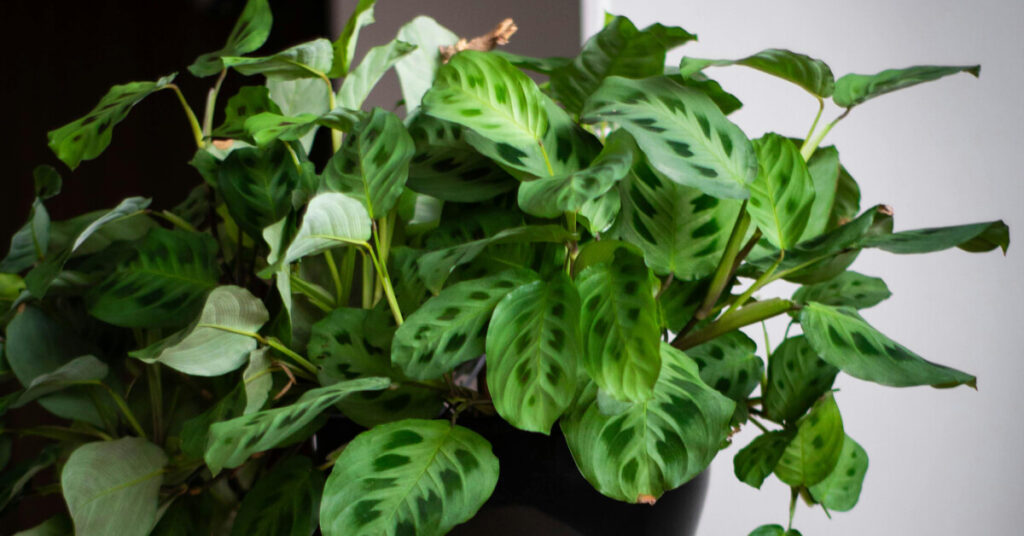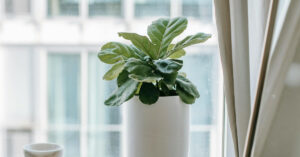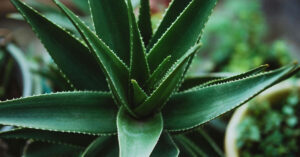Maranta leuconeura
There’s something almost magical about watching a Prayer Plant fold its leaves upward each evening, as if offering a quiet prayer to the night sky. This remarkable houseplant, with its stunning patterned foliage and unique nyctinastic movement, has captured the hearts of plant enthusiasts worldwide. The Prayer Plant’s ability to literally move its leaves in response to light changes creates a living, breathing presence in your home that feels more like a gentle companion than a static decoration.
Native to the tropical rainforests of Brazil, the Prayer Plant brings an exotic elegance to indoor spaces with its broad, oval leaves decorated in intricate patterns of deep green, light green, and cream markings with distinctive red veining. The undersides reveal a beautiful reddish-purple hue that becomes visible as the leaves fold upward each evening, creating a dramatic transformation that never fails to fascinate observers.
While the Prayer Plant requires more attention than some houseplants, the reward of successfully growing this botanical marvel makes every effort worthwhile. Its striking appearance, fascinating behavior, and air-purifying qualities make it a prized addition to any plant collection, despite its reputation for being somewhat particular about its care requirements.
Understanding the Prayer Plant’s Fascinating Movement
The Prayer Plant’s most distinctive feature is its ability to move its leaves throughout the day in response to light changes. This phenomenon, called nyctinasty, is controlled by a specialized joint called a pulvinus at the base of each leaf. During the day, the leaves spread horizontally to maximize light absorption, while at night they fold upward into a prayer-like position, hence the common name.
This movement serves important biological functions in the plant’s natural habitat. The upward folding at night helps conserve moisture and protect the leaf surfaces from cool nighttime temperatures. In the morning, as light returns, the leaves gradually unfold to resume their horizontal position, ready to capture the day’s energy for photosynthesis.
The dramatic nature of this movement means you’ll notice your Prayer Plant constantly changing its appearance throughout the day. New plant parents often worry when they see leaves moving, but this is completely normal and indicates a healthy, responsive plant. The movement is most pronounced in plants receiving adequate light and proper care.
Mastering Light Requirements for Healthy Growth
Prayer Plants thrive in bright, indirect light that mimics the dappled sunlight of their native rainforest understory. Place your plant near an east or north-facing window, or several feet back from a south-facing window where it receives plenty of ambient light without harsh direct sun exposure.
Direct sunlight can quickly damage Prayer Plant leaves, causing them to fade, develop brown spots, or even scorch completely. The delicate foliage is particularly sensitive to intense afternoon sun, which can bleach the beautiful patterns and cause irreversible damage. If you notice the leaf colors becoming washed out or pale, move your plant to a location with gentler light.
Insufficient light presents its own challenges, causing the plant to lose its vibrant leaf patterns and potentially reducing the dramatic nighttime movement. In low light conditions, the Prayer Plant may also become leggy as it stretches toward available light sources. If natural light is limited, consider supplementing with a grow light positioned 12-18 inches above the plant.
Watering Wisdom for Tropical Success
Getting the watering routine right is crucial for Prayer Plant success, as these plants prefer consistently moist but never waterlogged soil. Water when the top inch of soil feels slightly dry, typically every 3-5 days during the growing season and less frequently in winter when growth slows.
Use room temperature, filtered or distilled water when possible, as Prayer Plants are sensitive to chemicals commonly found in tap water, particularly fluoride and chlorine. These chemicals can cause brown leaf tips and edges, which are often the first signs of water quality issues. If you must use tap water, let it sit out overnight to allow chlorine to evaporate before using.
When watering, apply water slowly and evenly across the soil surface until it begins draining from the bottom holes. Empty any water that collects in the saucer within 30 minutes to prevent root rot. The Prayer Plant’s root system is relatively shallow and can quickly suffer in soggy conditions, so proper drainage is essential.
Creating the Perfect Soil Environment
Prayer Plants require a well-draining potting mix that retains moisture while allowing excess water to escape freely. A high-quality potting mix amended with peat moss or coco coir works excellently, as these materials help maintain the slightly acidic conditions Prayer Plants prefer while improving moisture retention.
You can create an ideal blend using equal parts potting soil, peat moss, and perlite, with a small amount of orchid bark for additional drainage. The soil should feel moist and spongy when squeezed but not soggy or waterlogged. A pH between 6.0-6.5 is ideal for optimal nutrient uptake.
Repot your Prayer Plant every 1-2 years or when it becomes rootbound, typically in spring when new growth begins. Choose a container only slightly larger than the current pot, as Prayer Plants prefer to be somewhat rootbound and can struggle in overly large containers that hold too much moisture.
Temperature and Humidity Management
Prayer Plants are tropical plants that require warm, stable temperatures between 65-80°F (18-27°C) to thrive. These plants are particularly sensitive to cold drafts and sudden temperature changes, which can cause leaf curling, browning, or even leaf drop. Keep your plant away from air conditioning vents, heating sources, and frequently opened doors or windows.
High humidity is absolutely critical for Prayer Plant success, with these plants preferring levels of 50-60% or higher. In typical indoor environments, especially during winter heating seasons, this often requires artificial humidity enhancement. Use a humidifier, group plants together, or place the pot on a pebble tray filled with water to create a more humid microclimate.
Low humidity quickly manifests as brown, crispy leaf edges and increased susceptibility to spider mites. If you notice these symptoms, address humidity levels immediately. Regular misting can help temporarily, but be careful not to mist excessively as this can promote fungal issues on the delicate foliage.
Fertilizing for Vibrant Foliage
During the growing season (spring through early fall), feed your Prayer Plant every 2-3 weeks with a balanced, water-soluble fertilizer diluted to quarter strength. Prayer Plants are sensitive to over-fertilization, which can cause brown leaf tips and edges similar to water quality issues.
A 10-10-10 or 20-20-20 fertilizer works well when properly diluted. Always apply fertilizer to moist soil to prevent root burn, and reduce or eliminate feeding during winter months when growth naturally slows. Signs of over-fertilization include brown leaf margins, excessive soft growth, and salt buildup on the soil surface.
Organic fertilizers like compost tea or diluted fish emulsion can provide gentler nutrition that’s less likely to cause burning. Whatever fertilizer you choose, remember that Prayer Plants prefer light, frequent feeding rather than heavy, infrequent applications.
Pruning and Maintenance
Regular maintenance helps keep your Prayer Plant looking its best and promotes healthy growth. Remove any yellowing, damaged, or brown leaves promptly by cutting them at the base of the stem. This prevents potential disease issues and keeps the plant’s energy focused on healthy foliage.
Prayer Plants naturally produce new growth from the center of the plant, so there’s rarely a need for extensive pruning. However, you can trim back any leggy or damaged stems to encourage bushier growth. Always use clean, sharp scissors or pruning shears to prevent disease transmission.
Brown leaf tips and edges are common with Prayer Plants and usually indicate low humidity, water quality issues, or over-fertilization. While these brown areas won’t turn green again, you can trim them with scissors to improve the plant’s appearance, being careful to maintain the natural leaf shape.
Propagation Through Division
The best way to propagate Prayer Plants is through division during repotting. Carefully separate the plant into smaller sections, ensuring each division has both roots and shoots. This method typically has higher success rates than other propagation techniques and produces mature plants more quickly.
When dividing, use a clean, sharp knife to cut through the root system, making sure each section has adequate roots to support new growth. Plant each division in its own pot with fresh, well-draining soil and keep the soil consistently moist while the plants establish.
Some varieties of Prayer Plant can also be propagated from stem cuttings, though this method is more challenging and less reliable. If attempting cutting propagation, take 4-6 inch cuttings with several nodes and root them in water or moist potting mix under high humidity conditions.
Common Challenges and Solutions
Prayer Plants can face several common issues that often frustrate new owners. Spider mites are the most frequent pest problem, especially in dry conditions. These tiny pests cause stippling on leaves and may produce fine webbing. Increase humidity immediately and treat with insecticidal soap or neem oil for effective control.
Brown leaf tips and edges are perhaps the most common complaint with Prayer Plants. This issue usually stems from low humidity, poor water quality, or over-fertilization. Address the underlying cause rather than just trimming the brown areas, as the problem will continue without proper correction.
Leaf curling can indicate several issues: underwatering, low humidity, temperature stress, or pest problems. Examine your plant carefully to determine the cause, checking soil moisture, humidity levels, and inspecting for pests before taking corrective action.
Appreciating Varieties and Cultivars
While Maranta leuconeura is the true Prayer Plant, several beautiful varieties offer different leaf patterns and colors. ‘Erythroneura’ (also called Red Prayer Plant) features prominent red veining, while ‘Kerchoveana’ displays distinctive dark green spots that earn it the nickname “Rabbit’s Foot.” The ‘Massangeana’ variety shows beautiful herringbone patterns with silver markings.
Each variety has slightly different care requirements, with some being more tolerant of lower humidity or different light conditions. Research the specific needs of your variety to provide the best possible care, as what works for one cultivar may not be ideal for another.
The diversity of Prayer Plant varieties means you can create a stunning collection with different colors, patterns, and sizes while maintaining similar care routines. This makes them perfect for enthusiasts who want to specialize in these remarkable plants.
Embracing the Prayer Plant Journey
Successfully growing Prayer Plants requires patience, attention to detail, and a willingness to learn from both successes and setbacks. These plants reward careful observation and consistent care with stunning foliage displays and the daily miracle of their leaf movements.
The Prayer Plant’s combination of beauty, movement, and challenge makes it a rewarding choice for plant enthusiasts ready to move beyond basic houseplants. While it may require more attention than some plants, the daily joy of watching its leaves dance with the light makes every effort worthwhile, creating a living masterpiece that brings tropical elegance and natural wonder to your indoor garden.




